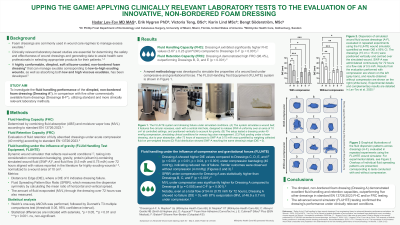Laboratory Research
(LR-034) Upping the Game! Applying Clinically Relevant Laboratory Tests to the Evaluation of an Innovative, Non-bordered Foam Dressing
Friday, May 2, 2025
7:45 PM - 8:45 PM East Coast USA Time

Hadar Lev-Tov, MD MAS – Dr Phillip Frost Department of Dermatology and Cutaneous Surgery – University of Miami, Miller School of Medicine
Introduction: Wound dressings are designed to create an optimal microenvironment that supports healing, with effective management of wound exudate being a key function. Key properties such as absorption, retention, and vapour permeability enable dressings to maintain moisture balance and prevent complications like maceration. Additionally, dressings must handle exudate of varying compositions under mechanical forces, e.g. compression bandaging or gravitational pull. Recent studies emphasise the need for clinically relevant testing standards to enable objective, standardised comparisons between dressings (1, 2).
Methods: In vitro methods were used to evaluate the fluid handling capacity (FHC) and fluid retention capacity (FRC) of an innovative, dimpled, soft silicone-coated non-bordered foam dressing* and five other commercially available foam dressings following EN 13726:2023 standards. To better replicate clinical conditions, advanced tests were conducted using the FLUHTE (FLUid Handling Test Equipment) wound simulator with simulated wound fluid (SWF-A) (3), which mimics wound exudate properties. Dressings were positioned vertically on the FLUHTE to simulate the effects of gravity on fluid movement.
Results: The EN 13726:2023 standard methods revealed substantial differences in fluid handling performance among the six non-bordered foam dressings tested. The innovative, dimpled, soft silicone-coated non-bordered foam dressing* outperformed the other five in FHC and/or FRC tests, demonstrating its absorption, retention, and vapour release capabilities. When evaluated using the FLUHTE wound simulator, the innovative dressing* maintained excellent performance even under the additional challenge of compression bandaging. These findings underscore the limitations of the EN 13726:2023 standard and highlight the importance of dynamic methods like FLUHTE for replicating real-world conditions and delivering clinically relevant insights.
Discussion: The innovative, dimpled, soft silicone-coated non-bordered foam dressing* demonstrated unique fluid handling performance, even under mechanical forces such as compression or gravity. These findings support expanding the EN 13726:2023 standard to incorporate dynamic testing methods like FLUHTE. Adopting such advancements would better align dressing performance metrics with the complexities of wound care, ultimately supporting improved clinical outcomes.
Methods: In vitro methods were used to evaluate the fluid handling capacity (FHC) and fluid retention capacity (FRC) of an innovative, dimpled, soft silicone-coated non-bordered foam dressing* and five other commercially available foam dressings following EN 13726:2023 standards. To better replicate clinical conditions, advanced tests were conducted using the FLUHTE (FLUid Handling Test Equipment) wound simulator with simulated wound fluid (SWF-A) (3), which mimics wound exudate properties. Dressings were positioned vertically on the FLUHTE to simulate the effects of gravity on fluid movement.
Results: The EN 13726:2023 standard methods revealed substantial differences in fluid handling performance among the six non-bordered foam dressings tested. The innovative, dimpled, soft silicone-coated non-bordered foam dressing* outperformed the other five in FHC and/or FRC tests, demonstrating its absorption, retention, and vapour release capabilities. When evaluated using the FLUHTE wound simulator, the innovative dressing* maintained excellent performance even under the additional challenge of compression bandaging. These findings underscore the limitations of the EN 13726:2023 standard and highlight the importance of dynamic methods like FLUHTE for replicating real-world conditions and delivering clinically relevant insights.
Discussion: The innovative, dimpled, soft silicone-coated non-bordered foam dressing* demonstrated unique fluid handling performance, even under mechanical forces such as compression or gravity. These findings support expanding the EN 13726:2023 standard to incorporate dynamic testing methods like FLUHTE. Adopting such advancements would better align dressing performance metrics with the complexities of wound care, ultimately supporting improved clinical outcomes.

.jpg)